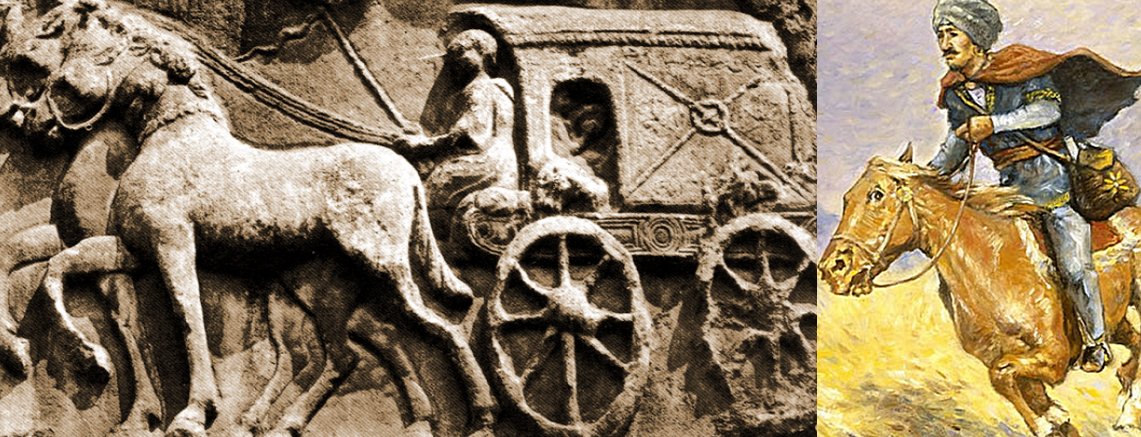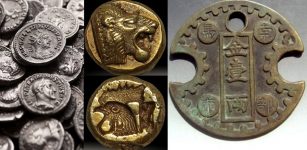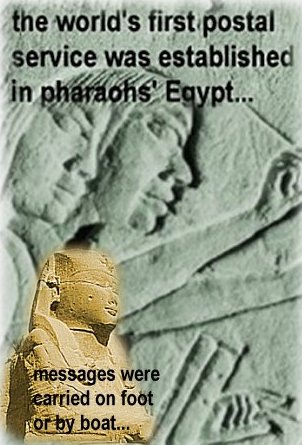Struggle To Get Mail On Time Has Lasted More Than 5,000 Years – Part 1
A. Sutherland - AncientPages.com - King Sargon of Babylon, who ruled about 3800 B.C. established a regular postal service for his official letters which could reach recipients even in the most distant locations.
Herodotus wrote that "neither rain, nor snow, nor heat, nor gloom of night stays the couriers from the swift completion of their appointed rounds."
The Old Testament contains many references to the post. Ancient people of Persia had "airmail" with homing pigeons and the Aztecs and Inca had fast runners who delivered messages with express speed.
What was the most important for all these ancient cultures and their letter delivery? Whatever method they used to get their messages delivered, they had one, primary and common goal: to get the mail on time.
The struggle to get the mail on time has lasted more than 5,000 years.
Pharaohs of ancient Egypt founded the first postal system and regarded the post so important that their ancient postmen are depicted on the walls of royal tombs. When the power of pharaohs grew, the need of information increased as well.
The two kingdoms of Upper and Lower Egypt were united c. 3000 BC, and secure exchange of information was necessary to keep two kingdoms loyal to one another, especially in times of trouble.
Trustworthy messengers were sought and pharaoh established a team of couriers who memorized information in order to deliver it verbally rather to the Kingdom's officials than risk enemy capture of written documents.
Neither the pharaoh nor his officials could remember all the information regarding army equipment or foregone tax revenues.
An archive was a solution when the bureaucracy began to grow significantly and the need of storing of written documents emerged.
The system of ancient hieroglyphics developed by Egyptian civilization played an important role when the world's first postal service was established as well as the invention of papyrus sheets rolled up into scrolls gave enough place for large amounts of information. The Egyptian kingdom became complex and the need of secure and fast communication was urgent.
In this way, the first postal system was established. The records say it took place around 2200 BC. The pharaoh's couriers were able to deliver papyrus scrolls with orders and laws to all the kingdom's provinces and to the pharaoh's officials were delivered financial status reports and other documents of¨of significant value for the kingdom.
The Egyptian mail delivery system had also another important purpose: it linked the government with military outposts throughout Egypt.
Most Egyptian mail couriers carried their messages on foot or by boat. Some of the history's first letters written on clay tablets survived to the present day. They were imperishable because fire made them only harder and they originate from Persia.
Around 450 BC, Herodotus described a well-functioning postal service in Persia that was based on relays of horses stationed at one-day intervals at stations manned by officials who would receive a letter and send it off with fresh riders on fresh horses.
Messages between the monarchy and officials in very remote parts of the country were picked up and delivered as soon as possible!
Along the main, 55 mil-long road, so called King's Road, there were many low-post centers where a rested horse and a new messenger were waiting to take over all issues and deliver them as quickly as possible.
Early "letters" were carved on dried clay tablets (the Persians had no paper), with dense rows of cuneiform writing.
Letters and other messages have existed from the time of ancient India, Sumer, ancient Egypt through Rome, Greece and China, up to the present day. This form of communication co-existed along with humans.
Letters make up several of the books of the Bible and large archives of personal, diplomatic, or business correspondence serve as primary source of knowledge about the ancients.
One thing, however, we have to remember! Prehistoric mail delivery was not similar to that we know today. During ancient times, only government and military officials could use the postal system.

Left: Roman Empire had the well documented and perfectly functioning postal service which was formed under Augustus Caesar. It was called Cursus publicus; Right: Mail courier in Persia
Everyone else had to hire their own messengers to deliver a letter to another person or use one of the most reliable postmen in the world - "homing pigeon". They have carried our messages for 5,000 years, which is confirmed in many ancient records of this planet. The Persians, for example, were one of those who systematically used "homing pigeons" to send their messages.
And surprisingly, in 1860, Reuter's news agency had as many as 45 (!) "homing pigeons" which delivered news between Brussels and Berlin. Lack of the telegraph lines, forced the agency to do it and it worked!
The Roman Empire built the most advanced postal delivery system; riders could cover about 170 miles (270 kilometers) in a 24-hour period. Fast and reliable communication between Rome and governors and military officials in distant provinces was a necessity.
Approximately 2000 relay stations located with intervals, were located along most important roads of the empire. The stations were equipped with horses, spare parts and a man who took care of the animals and provided the couriers with food and drink. Additionally, one could hire mules and ox-carts for larger packages.
Worth mentioning is that the speed with which government dispatches and other mail could be carried about the Roman Empire, was not equaled again in Europe until the 19th century.
At the same time, the so called "cursus publicus" (state-run courier and transportation service) of the Roman Empire was operational and delivered mail to ordinary people.
Written by – A. Sutherland AncientPages.com Staff Writer
Copyright © AncientPages.com All rights reserved. This material may not be published, broadcast, rewritten or redistributed in whole or part without the express written permission of AncientPages.com
More From Ancient Pages
-
 Ancient Round Coins Were Invented To Prevent Fraud
Ancient History Facts | Mar 21, 2018
Ancient Round Coins Were Invented To Prevent Fraud
Ancient History Facts | Mar 21, 2018 -
 Pooka: Solitary Spirit And Not Entirely Benevolent Prankster In Irish Folklore
Celtic Mythology | Jun 4, 2016
Pooka: Solitary Spirit And Not Entirely Benevolent Prankster In Irish Folklore
Celtic Mythology | Jun 4, 2016 -
 Shipboard Cannon Found On The Swedish West Coast May Be Europe’s Oldest!
Archaeology | Sep 12, 2023
Shipboard Cannon Found On The Swedish West Coast May Be Europe’s Oldest!
Archaeology | Sep 12, 2023 -
 Mysterious Disappearance Of The Eilean Mor Lighthouse Keepers Remains Unsolved
Featured Stories | Dec 21, 2018
Mysterious Disappearance Of The Eilean Mor Lighthouse Keepers Remains Unsolved
Featured Stories | Dec 21, 2018 -
 Huge Ancient Animal Sculptures Made By Unknown Carvers At Camel Site In Saudi Arabia Puzzle Archaeologists
Archaeology | Feb 14, 2018
Huge Ancient Animal Sculptures Made By Unknown Carvers At Camel Site In Saudi Arabia Puzzle Archaeologists
Archaeology | Feb 14, 2018 -
![Photo taken on Dec 20, 2015 shows hoof-shaped gold ware unearthed from the main coffin in the Haihunhou (Marquis of Haihun) cemetery, East China's Jiangxi province. [Photo/Xinhua]](https://www.ancientpages.com/wp-content/uploads/2015/12/MarquisofHaihuntomb1-307x150.jpg) Does A 2,000-Year-Old Tomb Belong To Marquis of Haihun? – Search For His Seal Continues
Archaeology | Dec 25, 2015
Does A 2,000-Year-Old Tomb Belong To Marquis of Haihun? – Search For His Seal Continues
Archaeology | Dec 25, 2015 -
 Beer And Hallucinogens Reinforced The State Of The Wari Culture
Archaeology | Jan 15, 2022
Beer And Hallucinogens Reinforced The State Of The Wari Culture
Archaeology | Jan 15, 2022 -
 Dazzling Time Capsule Of Unique Iron Age Artifacts And Celtic Roundhouses Discovered In England
Archaeology | Mar 15, 2022
Dazzling Time Capsule Of Unique Iron Age Artifacts And Celtic Roundhouses Discovered In England
Archaeology | Mar 15, 2022 -
 Why Did Neanderthals Visit A Special Cave In Jersey For Over 100,000 Years?
Archaeology | Dec 13, 2016
Why Did Neanderthals Visit A Special Cave In Jersey For Over 100,000 Years?
Archaeology | Dec 13, 2016 -
 10 Most Bizarre Forms Of Ancient Taxes: Surprising And Funny
Featured Stories | Nov 21, 2016
10 Most Bizarre Forms Of Ancient Taxes: Surprising And Funny
Featured Stories | Nov 21, 2016 -
 Kantyua And Tantyua – Sacred Tibetan Books Reveal Incredible Lifespan Of The Gods
Artifacts | Mar 18, 2019
Kantyua And Tantyua – Sacred Tibetan Books Reveal Incredible Lifespan Of The Gods
Artifacts | Mar 18, 2019 -
 Cerberus – Giant Multi-Headed Dog Guards The Underworld Of God Hades In Greek Mythology
Featured Stories | Jun 2, 2020
Cerberus – Giant Multi-Headed Dog Guards The Underworld Of God Hades In Greek Mythology
Featured Stories | Jun 2, 2020 -
 On This Day In History: Independence Of Lower Canada – Today Quebec – Proclaimed On Feb 28, 1838
News | Feb 28, 2017
On This Day In History: Independence Of Lower Canada – Today Quebec – Proclaimed On Feb 28, 1838
News | Feb 28, 2017 -
 Scientists Question Whether Meat Eating Really Changed Human Evolution
Archaeology | Jan 25, 2022
Scientists Question Whether Meat Eating Really Changed Human Evolution
Archaeology | Jan 25, 2022 -
 Quatrefoil Symbol Was Used By The Olmecs And Maya Long Before It Appeared On Christians Churches
Ancient Symbols | Mar 19, 2018
Quatrefoil Symbol Was Used By The Olmecs And Maya Long Before It Appeared On Christians Churches
Ancient Symbols | Mar 19, 2018 -
 Curious 6,000-Year-Old Skull May Confirm Mythical Ancient Tribe Of Small Dark-Skinned People Did Exist!
Archaeology | Oct 11, 2022
Curious 6,000-Year-Old Skull May Confirm Mythical Ancient Tribe Of Small Dark-Skinned People Did Exist!
Archaeology | Oct 11, 2022 -
 Massive Well-Preserved Second Temple-Era Aqueduct Unearthed In Jerusalem
Archaeology | Aug 29, 2023
Massive Well-Preserved Second Temple-Era Aqueduct Unearthed In Jerusalem
Archaeology | Aug 29, 2023 -
 Evidence Of Europe’s Earliest Human Presence, Dating Back 1. 3 Million Years Found At Venta Micena, Iberian Peninsula
Evolution | Jul 13, 2024
Evidence Of Europe’s Earliest Human Presence, Dating Back 1. 3 Million Years Found At Venta Micena, Iberian Peninsula
Evolution | Jul 13, 2024 -
 Pyla-Koutsopetria: Complexity Of Ancient Fortifications Of Pyla-Vigla, Cyprus – Explored
Archaeology | Oct 15, 2019
Pyla-Koutsopetria: Complexity Of Ancient Fortifications Of Pyla-Vigla, Cyprus – Explored
Archaeology | Oct 15, 2019 -
 Ushabti: Servants Who Worked For Their Owners In Afterlife In Ancient Egyptian Beliefs
Ancient History Facts | Feb 12, 2020
Ushabti: Servants Who Worked For Their Owners In Afterlife In Ancient Egyptian Beliefs
Ancient History Facts | Feb 12, 2020


